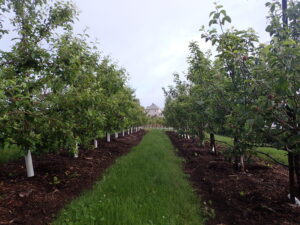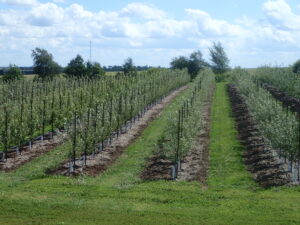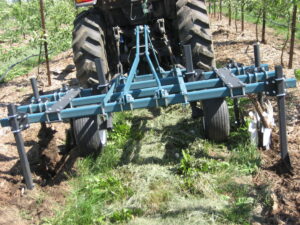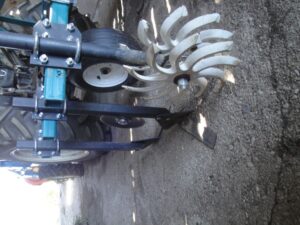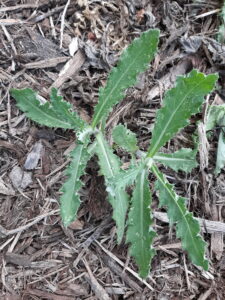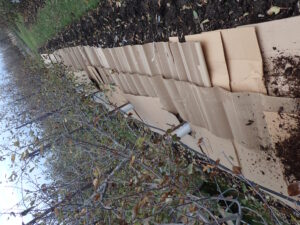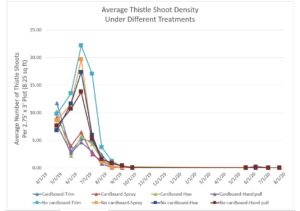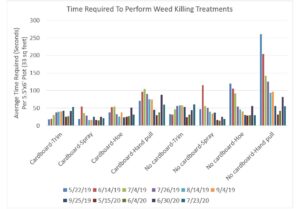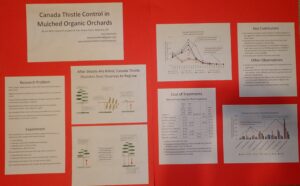Final report for FNC19-1181
Project Information
Chris and Juli McGuire have operated Two Onion Farm since 2003. From 2003-2017, we raised up to 5 acres of organic mixed vegetables. In 2012 we began planting organic apples, and we increased our orchard in subsequent years. Currently we grow two acres of apples and a half acre of currants and gooseberries. We transitioned our farm from vegetables to fruit to meet a strong market demand for local organic fruit and to protect our hillside soils from erosion with a perennial crop. We market our apples through a community-supported agriculture (CSA) program, to local grocery stores and chefs, and by processing them into applesauce and apple butter.
We raise trellised dwarf trees in our orchard. Since we started our orchard, we have employed several sustainable practices: we grow disease-resistant varieties which require minimal organic fungicide sprays. We use bark mulch under our trees to reduce weed competition, supply nutrients and organic matter, and nourish beneficial soil fungi. We encourage beneficial insects in the orchard, scout daily for pests, monitor weather to predict pest outbreaks, and only spray organic pesticides as a last resort.
Most apple farmers raise dwarf trees because the dwarf trees generally provide a quicker return on investment, produce better quality fruit, require less labor, suffer less disease and are easier to spray. However, dwarf trees have shallow root systems and compete poorly with weeds. Many organic apple growers with dwarf trees rely on wood chip or bark mulch (by-products from local sawmills) to suppress annual weeds around their trees, but over time aggressive perennial weeds such as Canada Thistle can invade the mulched area. Canada Thistle has deep roots and once established it is very difficult to eliminate using organic methods. Repeatedly killing thistle shoots by mowing or other means can deplete thistle’s root reserves and gradually suppress or eliminate it. Unfortunately, this repeated killing is time-consuming and difficult to accomplish on a commercial scale.
We measured the cost and effectiveness of four methods of killing Canada thistle shoots in our apple orchard: hand-pulling, spraying with an organic herbicide, mowing with a string trimmer, and cutting shoots off with a hoe. Based on previous research, we applied these four methods every three weeks during the growing season: a three week interval is needed to deplete the thistle's energy reserves stored in the roots. We evaluated each technique in plots mulched with bark only and in plots mulched with both bark and cardboard.
Our main conclusions were:
(1) All methods of killing shoots at three week intervals were extremely effective and completely eliminated thistle within two growing seasons.
(2) A layer of cardboard mulch underneath the bark mulch reduced thistle populations more quickly than bark mulch alone. Installing cardboard took more time than it saved later in killing thistles, however, so it is probably worthwhile only if it can be done at times of the year when labor is plentiful.
(3) Of the four shoot-killing methods, hoeing and string-trimming were least expensive. Hand-pulling was expensive because it required a lot of labor. Spraying with an organic herbicide was quick and effective, but expensive because of the high cost of the herbicide.
Based on these results, we have implemented hoeing in our own orchard to kill established thistle patches. We have shared results through email list serves, our website, a field day, conferences, and several printed publications and newsletters (some of which will only be printed after the end of the grant period). Many farmers expressed interest in our results and implementing similar techniques on their own farms.
- Compare four methods of repeatedly killing Canada thistle shoots in our mulched apple orchard: hand-pulling, spraying with an organic herbicide, mowing with a string trimmer, and cutting shoots off with a hoe.
- Evaluate each method in plots mulched with bark only and in plots mulched with both cardboard and bark.
- Measure time required and effectiveness at reducing thistle populations for each treatment.
- Share results with other organic apple growers through our website, a field day, emails to grower list-serves, articles in grower publications, and conferences.
Research
General Orchard Management. Our dwarf apple trees are planted 6' apart within the row and approximately 10.5' between rows. Under each tree row, we attempt to maintain a 5.5' weed-free strip. This strip is mulched with 4" of hardwood bark after trees are planted, and we apply 1-2" of additional bark each subsequent year in late fall, winter, or early spring. In between rows, we maintain a grass/clover sod approximately 4' wide. Between the sod and the mulch we maintain a narrow strip of bare soil (about 6" wide) by using a homemade three point hitch mounted cultivator. The following two pictures show areas of the orchard where no thistles are present. Shame and self-loathing prevented us from taking pictures of the dense thistle patches which were present at the beginning of this project.
These are two pictures of the cultivator which we use to separate the sod from bark mulch:
This experiment relates to Canada thistle control in the bark mulched strip. We have found that weekly close mowing of grass aisles and cultivation of the cultivated strip every 7-14 days when soil conditions permit is sufficient to largely control or eliminate thistle in those areas, but that thistle can proliferate in the mulched strips. Once it invades the mulched area, it spreads rapidly via underground runners. The runners are very deep, and there is no practical way to dig them out with uprooting the apple trees as well. However, previous research by others has shown that Canada thistle populations can be reduced if the aboveground shoots are repeatedly cut back every three weeks, which depletes the plant's underground food reserves. Our goal was to confirm whether this was true and to identify the most cost-effective method of cutting shoots back.
In addition to Canada thistle, there are several other common weeds in our orchard. Bark mulch controls most annual weeds, presumably by blocking sunlight from reaching dormant weed seeds in the soil below. Crabgrass and other annuals do sometimes establish at the edge of the mulch where cultivation disturbs the soil/mulch border. Dandelions invade the mulch over time as windblown seeds germinate on top of the mulch. Quackgrass and Canada thistle invade the mulch and once there, spread aggressively via underground runners. Fescue and white clover from the sod strips rarely invade the mulch.
Our orchard consists of scab-resistant varieties grown on dwarf rootstocks. The thistle-infested blocks used in this study include these varieties: Initial, Sansa, Winecrisp, Pristine, Akane, Redfree, Williams Pride, and Prima. Rootstocks in these blocks are primarily G. 11, G. 16, and G.41, with small amounts of G. 202 and Bud. 9.
Layout of Experimental Plots. I selected 14 blocks (each 5.5'x48') in our orchard where Canada thistle is abundant. I divided each block into eight plots (5.5'x6'): 5.5' is the width of the mulched strip under our apple trees and our trees are spaced 6' apart, so each plot was centered on a single tree. I randomly assigned the eight plots in each block to one of eight treatments (the eight treatments were four methods of killing thistle shoots, each performed with and without cardboard mulch).
Cardboard Mulch. Cardboard mulch may reduce thistle shoot density and make other treatments less time-consuming to apply. Cardboard will not completely eliminate thistles because some shoots always emerge at seams and edges in the cardboard mulch. Used cardboard is a readily available mulch which biodegrades within two growing seasons. I chose cardboard instead of plastic mulch to avoid reliance on synthetic, non-recyclable products. We applied cardboard mulch in April, 2019: we first removed bark mulch from these plots, then laid recycled cardboard on the ground, overlapping cardboard pieces by 6-12″ at edges, and finally reapplied bark mulch on top of cardboard. We recorded the time required to apply the cardboard.
This picture shows cardboard mulch after it has been laid, but before bark has been placed on top of the cardboard:
Thistle killing methods. I selected four methods of killing thistle shoots based on experience and published results.
(1) Hand-pulling – a basic, effective, but usually time-consuming method. We pulled out each weed with as much of its underlying vertical root as was easily removable - in some cases thistle shoots broke off near the surface and in other cases we removed up to 6 or 8 inches of below ground stem.
(2) Hoeing – We used a flat bladed diamond hoe (Dewit #31-10). These work well in bark mulch because a user can easily slide the blade under the mulch without disturbing the mulch excessively. When hoeing, we aimed to cut each shoot below the surface of the mulch, but above the cardboard mulch or soil.
(3) Spraying – I chose Avenger Weed Killer Concentrate OMRI-listed herbicide (active ingredient Limonene) because it has effectively killed Canada thistle shoots in small tests on our farm and because it works in cloudy and cool conditions, unlike some other organic herbicides. It is not toxic to the trunks of apple trees. We mixed 1 quart of Avenger with 3 quarts of water to make one gallon of spray solution and thoroughly doused weeds to the point of runoff.
(4) String trimming – We used a Honda HHT35 string trimmer to cut all weeds off as close to the mulch surface as possible.
When we applied these treatment we applied them to all weeds in the experimental plots, not just Canada thistle. We felt that this was the most realistic way that practicing farmers would apply the treatments on their farms.
Every three weeks from May to September we performed weed killing treatments. (Treatment dates in 2019 were May 22, June 14, July 4-5, July 26, August 14, September 4, and September 25; treatment dates in 2020 were May 15, June 4, June 30, and July 23; no thistles were observed in experimental plots at the last two treatments, and treatments were halted at that time). We chose a three week interval because other research has shown that this interval depletes Canada thistle’s root reserves and will gradually suppress or eliminate the weed. Longer intervals allow the thistle to recoup and accumulate resources in between treatments.
We recorded the time required for each treatment in each plot; setup/cleanup time required for each treatment (e.g., filling and rinsing sprayer tank, adding gas to string trimmer); and the amount of spray and gas used.
Thistle Density Data. Canada thistle shoots can be dense (>10 per square foot). To reduce time required for data collection, I only counted shoots in one quarter of each plot; I selected the northeast quarter arbitrarily. I counted live thistle shoots on April 23, 2019, before applying cardboard mulch, and again immediately before applying each round of thistle killing treatments. I counted each thistle shoot emerging from the bark mulch as one shoot, although in some cases several shoots may have originated as branches of a single shoot which diverged below the surface of the mulch.
Thistle Shoot Density. As the graph below shows, thistle shoot density declined dramatically in all treatments over the course of the first year and remained low during the second year. This confirms that any method of repeatedly killing thistle shoots on a three week interval will greatly reduce populations. Over all treatments, the thistle shoot density declined from a high of 1.438 shoots per square foot on 6/12/2019 to 0.005 shoots per square foot on 9/25/2019. It is difficult to overstate the extent of the decline - this was a 200 fold reduction in thistle density within one growing season! By the time of the last treatments in July, 2020, no thistle shoots were counted in the experimental plots. Another very evident trend was that cardboard mulching resulted in a much quicker reduction in thistle density. On 5/22/2019 and 6/12/2019, thistle densities in cardboard mulched plots was only 25-30% of the density in plots not mulched with cardboard. However, this difference declined thereafter and by the end of 2019 thistle density was near zero in all plots. In addition, the decline in thistle density in plots without cardboard mulch where weed trimming was used was slower than in plots without cardboard mulch where other treatments were used. This trend was particularly evident in density measurement data from 7/4/2019.
Time and Cost. The graph below shows the time required to perform each weed killing treatment over the course of the experiment (but not including the time to apply cardboard mulch). In general, hand-pulling was most time consuming, followed by hoeing, and trimming and spraying were least time consuming. Plots mulched with cardboard required less time to apply weed-killing treatments, presumably because they had fewer thistles (and fewer other weeds). However, the initial cardboard mulch application required an additional 546 seconds per tree, which was greater than the time savings during the rest of the experiment for any of the weed killing treatments.
The table below shows the cost per tree of applying each treatment over two seasons. Labor is valued at $15/hour, and the calculated costs also include the cost of herbicide and the cost of gas. Weed trimming without cardboard mulch was the least expensive treatment ($2.11 per tree). This is notable because this treatment actually resulted in the slowest reduction in thistle density. Spraying and hand pulling were the most expensive treatments; spraying required little labor, but the herbicide itself was very expensive. We assume that the recycled cardboard used in mulching is free (although the labor to apply it is not.)
Note that although cardboard mulch reduced thistle density and the time required to apply the subsequent weed killing treatments, it generally was not cost effective - the cost of applying the cardboard mulch outweighed the savings in reduced weeding time later in the year. Cardboard mulching was only cost effective in the spraying treatment, because the savings in herbicide costs with cardboard mulching justified the cost of mulching.
| Treatment | Cost of Time To Apply Weed Killing Treatments ($15/hour) | Cost of Time To Apply Cardboard Mulch ($15/hour) | Cost of Herbicide ($37.44 per gallon) | Cost of Gas Used in Trimmer ($2.22 per gallon) | Total Cost Per Tree |
| Cardboard-Trim | $ 1.57 | $ 2.28 | $ 0.03 | $ 3.87 | |
| Cardboard-Spray | $ 1.14 | $ 2.28 | $ 3.07 | $ 6.48 | |
| Cardboard-Hoe | $ 1.67 | $ 2.28 | $ 3.94 | ||
| Cardboard-Hand pull | $ 3.21 | $ 2.28 | $ 5.49 | ||
| No cardboard-Trim | $ 2.07 | $ 0.04 | $ 2.11 | ||
| No cardboard-Spray | $ 1.90 | $ 5.96 | $ 7.86 | ||
| No cardboard-Hoe | $ 2.64 | $ 2.64 | |||
| No cardboard-Hand pull | $ 4.96 | $ 4.96 |
We would advise other growers that any method of killing Canada thistle shoots on a three week interval will greatly reduce shoot density within a single year and will virtually eliminate Canada thistle within two years. In addition to the costs shown in the table above, there are other considerations in choosing a shoot killing method:
- If labor is particularly scarce in the late spring and summer, cardboard mulching may be justified if mulching can be done in fall or spring, thus saving time in the busier seasons.
- Weed trimming sometimes damaged the trunk guards on the apple trees. In addition, trunk guards are probably essential when using a weed trimmer to prevent accidental damage to tree trunks.
- A gas weed trimmer has other downsides not shown in the dollars and cents analysis above: noise, vibration, gas fumes, operator fatigue, and pollution of the orchard with microplastics as the cutting string is used up. In addition there is the upfront cost of the weed trimmer and the need for periodic maintenance (not included in the table above). Using a diamond hoe may be a more desirable alternative for some growers.
- Although we did not collect data on non-thistle weeds, we noticed over the course of the study that weed trimming was less effective than the other treatments in controlling other weeds, particularly crabgrass and dandelions. This is probably the reason why the time required for the weed trimming treatment did not decline over the course of the study, as it did in the other treatments. As thistle populations decline, the value of each treatment will depend more on the effectiveness of the treatment in controlling non-thistle weeds.
- Some weed killing treatments tend to cause the bark mulch to decay more quickly than others. Although we did not collect data on this, hoeing obviously caused the most rapid breakdown of the mulch, probably by mixing soil with the bark and aerating the bark. Hand-pulling and weed trimming were intermediate. Mulch breakdown was slowest in the sprayed treatment. Rapid mulch breakdown is probably undesirable because more mulch will need to be applied to maintain an effective mulch layer.
Educational & Outreach Activities
Participation Summary:
In summer 2019, we fielded a question via telephone related to this project from one cattle farmer in Iowa.
We hosted a field day at our farm, sponsored by CRAFT Angelic Learning Center, on July 14, 2020. There were 18 attendees. We spoke about the results of this project and distributed a handout describing our experiment and results to date: Field Day Handout July 2020. Ten attendees provided their email addresses and asked to receive a final summary of the project.
Research poster (pictured above) presented at MOSES Organic Farming Conference in February 2020. I do not know the total number of viewers for this poster because I was not present in the poster room for the entire conference. While I was at the poster, I spoke personally to approximately 25 poster viewers, mostly other organic fruit farmers.
On 12/9/2020, I presented at the Savanna Institute's Perennial Farm Gathering (held virtually). The presentation was about our use of hardwood bark mulch to control weeds and build soils in our orchard, and I discussed results of this project because this project addressed one of the key challenges with mulching. Fifty-eight participants were present; I estimate 35 were farmers and 23 were agriculture professionals. Numerous participants asked questions, including several related to thistle control. A copy of the presentation is here: PerennialFarmGatheringPresentation
In January 2021, I posted a summary of project results on our website. A copy of the summary is here: CanadaThistleFinalSummary.
I emailed this summary to several relevant list serves: Fairshare Farmers (350 members), Practical Farmers of Iowa-Horticulture (unknown number of members), Organic Fruit Growers (126 members), and Upper Midwest Craft (239 members). I was told later that my email was forwarded to other list serves, Organic Grain (OGRAIN), and western-wisconsin-small-farm-collaborative. Sixteen farmers and one researcher responded directly to me to ask questions, comment on their own experiences or to thank me for sharing the research results.
MOSES has agreed to publish an article summarizing the results from this project in the March, 2021 issue of the Organic Broadcaster newsletter and I submitted a 1200 word article to them on January 15th. (Organic Broadcaster Article Canada Thistle Chris McGuire)
The Organic Fruit Growers Association has agreed to publish an article summarizing the results from this project in the March, 2021 issue of their Just Picked newsletter, and I will submit an article to them in early February. (Just Picked Article Canada Thistle Chris McGuire)
The UW-Extension fruit crop team has agreed to publish an article summarizing research results in the coming spring (this newsletter is only published during the growing season). I submitted an article (WI Fruit News Article Canada Thistle Chris ) to them on January 15.
On January 22, 2021 I presented a powerpoint presentation and Lightning Talk at the Practical Farmers of Iowa virtual annual conference sharing the results of this research. A copy of the powerpoint is here: CanadaThistleControl
In January 2021, I submitted press releases to Agri-View and Country Today, two Wisconsin farming newspapers. Agri-View has stated that they will publish the press release in an upcoming issue. Press Release WI
Learning Outcomes
This grant project taught us several key lessons which we have shared with other farmers:
- It is possible to eliminate very dense Canada Thistle patches within 1-2 growing seasons by repeatedly cutting down the shoots on three week intervals.
- Of the shoot-killing methods we tried, hoeing and string trimming are more effective than hand-pulling and spraying an organic herbicide. On our own farm, we recommend hoeing over string trimming because hoeing is more pleasant, string trimmers have frequent maintenance issues, and hoeing is more effective against low-growing weeds in addition to Canada thistle.
- Mulching with recycled cardboard underneath our usual hardwood bark mulch hastened the reduction in thistle populations, but required too much time to be worthwhile unless cardboard mulch can be laid at less-busy times of year.
The advantages of this approach are clear: it can eliminate established thistle populations which would otherwise spread and proliferate. The disadvantage is the time and expense required. When possible, it's best to prevent thistle from establishing in the first place!
Project Outcomes
"This is excellent information. Our farm is not certified organic, but we are battling Canada thistle in our tree/shrub/prairie riparian buffer along our creek. We have been mowing and string trimming the thistle in an effort to deplete the carbohydrate growth nutrients in the root system. It is working to a degree. Your research supports that this is the most cost effective method; we just need to make sure we cut the shoots every 3 weeks. We have not cut the shoots that frequently." - Iowa farmer
"I've already sent this to friends and neighbors and will be trying it myself - thanks for sending, and for doing this work folks!" - Iowa farmer and farm advisor
"Thanks a lot for sharing your research . I learned a lot. We have missed the key; 3 wk interval, in our own efforts, and wonder if that timing is universal across different time zones. " -Central Iowa berry farmer
"I agree, this is very helpful! We struggle terribly on our farm with Canada thistle and have tried to use mowing to control it, but I see we need to bump up our frequency." - Illinois farmer and farm advisor
"Thank you SO MUCH for sharing your study. While I don’t have an orchard yet, I do have permanent pasture that is plagued with Canada thistle. I am confident these methods will work for my situation as well." - Illinois farmer
"I can't thank you enough for doing this work and sharing the information. 3 Weeks! That's it! We've been working on our Canada Thistle problem in our organic pumpkin fields for years but see that although we keep it from seeding, we are allowing it to regenerate with mowing at too long of an interval." - Wisconsin pumpkin farmer
